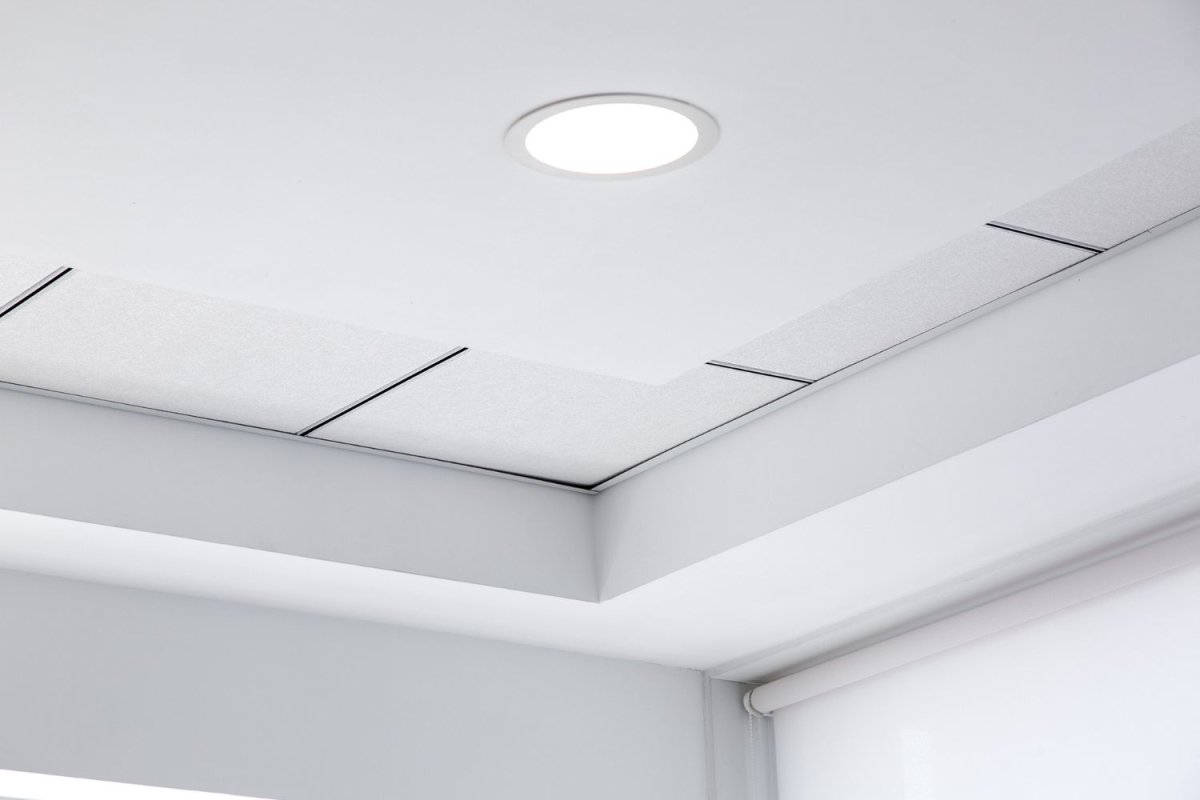We may earn revenue from the products available on this page and participate in affiliate programs. Learn More ›
Highlights
- Most homeowners spend between $1,063 and $3,190 on drop ceiling cost, with the national average at about $2,127.
- The cost to install a drop ceiling is largely dependent on the size of the ceiling, the material selected, the type of ceiling, and labor costs.
- Drop ceilings effectively offer noise reduction, mold resistance, better recessed lighting compatibility, and easier installation than a traditional ceiling.
- Experienced DIYers who don’t mind working on ladders can easily replace most ceiling tiles; however, professional installers and electricians are the best choice for full installation in a timely manner.
A drop ceiling can be an attractive ceiling choice that transforms a mundane room into a modern space. Also known as a suspended ceiling, a drop ceiling plays a functional role to cover up ductwork and structural elements, but the ceiling tiles selected can determine whether it dresses up the ceiling in a home or keeps it looking basic in a commercial setting.
According to Angi and HomeAdvisor, the average cost to install a drop ceiling is $2,127, though most drop ceilings cost between $1,063 and $3,190, making them a reasonable investment that offers several advantages for residential and commercial spaces. Ceiling size and tile materials are two of the factors that have the greatest effect on the total cost, but local labor costs and permits can also have a bearing.
Factors in Calculating Drop Ceiling Cost
The cost to install drop ceiling tiles can vary depending on factors such as ceiling size, labor costs, and installation methods. When estimating the cost of materials and installation for a drop ceiling, homeowners will want to consider these and other aspects of the project.
Ceiling Size
When it comes to drop ceiling installation costs, the size of the ceiling is one of the main factors to keep in mind. Generally speaking, the larger the ceiling, the higher the installation costs will be—though there are some exceptions.
The drop ceiling cost per square foot can range from $5 to $28, including labor costs. Homeowners can anticipate costs to be on the higher end for oversize ceilings. Additional materials may be required to account for cutting and trimming, creating a higher percentage of waste. However, buying materials in bulk may lower the per-square-foot cost in some scenarios, as will buying a cheaper ceiling tile material.
| Size of Ceiling | Average Cost (Materials and Labor) |
| 75 square feet | $375 to $2,100 |
| 125 square feet | $625 to $3,500 |
| 150 square feet | $750 to $4,200 |
| 200 square feet | $1,000 to $5,600 |
Tile Material
“When considering materials for drop ceilings, [homeowners can choose from options like] acoustic ceiling tiles, suspended drywall panels, metal ceiling panels, and vinyl ceiling tiles. Material selection depends on requirements, budget constraints, and aesthetic preferences,” explains Matt DiBara, fourth-generation contractor and CEO of The Contractor Consultants, a full-service hiring agency for construction companies. “However, for use, many homeowners often opt for ceiling tiles due to their ability to dampen sound effectively while also offering versatility in terms of appearance.”
Since drop ceiling tiles are available in several different materials, homeowners can easily customize their ceilings based on their needs and budget. Fiberboard is a cost-effective option that costs as little as $1 per tile. It’s known for sound reduction, but it can stain easily in humid environments. Plastic tiles cost between $5 and $9 per tile and offer moisture and stain resistance. Though plastic tiles are ideal for DIY installations, they can lack the aesthetic appeal of other materials.
Drop ceiling material costs increase with premium options such as metal and wood, which can cost as much as $20 to $70 per tile. However, they offer long-lasting durability and require less frequent replacement compared with more cost-effective options.
Grid Installation
A drop ceiling requires a grid or framework that supports the ceiling tiles. Intersecting metal strips, often shaped like an upside-down “T,” are suspended by wires from the room’s actual ceiling. The grid is attached to the walls, allowing contractors or homeowners to insert and move ceiling tiles easily and quickly.
Grid installation is a separate cost from tile materials, and homeowners can expect to pay anywhere from $1.50 to $2.25 per square foot for grid rails. The larger the space, the more grid rails needed to accommodate the appropriate number of tiles. When estimating drop ceiling costs, homeowners will want to calculate the totals for grid installation, the cost of materials, and estimated labor hours.
Labor
Most labor fees for drop ceilings can be charged one of two ways. Hourly rates can be anywhere from $30 to $85, with the upper range often found in urban areas or with more experienced workers.
Alternatively, if labor is billed per square foot, the price will range between $2 and $5. Whether charging by the hour or by the square foot, professional installers will cost more when they work on a larger room. A simple way to estimate labor costs is to calculate the area of the ceiling and multiply it by the median square foot price of $2.50.
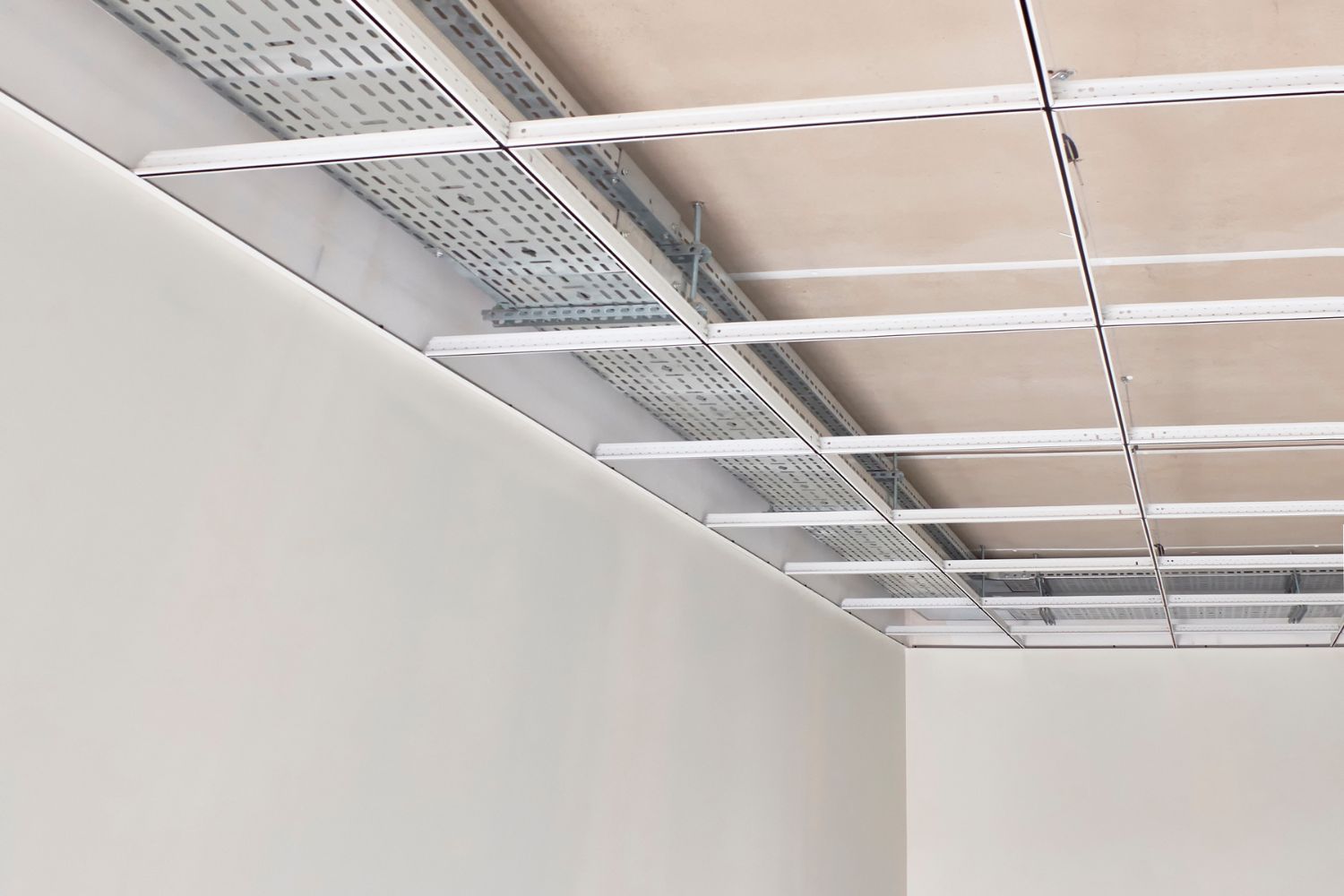
Additional Costs and Considerations
For drop ceiling installations, additional costs will likely need to be considered beyond the base price of materials and installation. The following are some of the more common scenarios homeowners may come across when budgeting for a drop ceiling.
Permits and Inspections
Homeowners can expect the average cost of drop ceiling installation to increase if a permit is required. Permits are issued in many areas to ensure new construction and renovations adhere to building codes. Usually, permits address the minimum ceiling clearance when it comes to dropped ceilings.
Just as the cost to vault a ceiling includes permit and inspection costs, so should an estimate for a dropped ceiling. The good news is that most professionals include the cost of permits in their quotes. They also handle the application process and scheduling of any required inspections, but homeowners are encouraged to verify this with the installer they hire. Homeowners can expect to pay around $150 for a dropped ceiling permit if one is required for their project.
Existing Ceiling Repair or Removal
Sometimes the first step to installing a drop ceiling is removing an existing ceiling. The cost to remove drop ceiling tiles ranges from $1 to $7 per square foot. The final drop ceiling replacement cost will depend on the size of the ceiling and the tile material chosen.
Ceiling repair costs vary by job, but some of the most common repairs include mold remediation and asbestos removal. Mold removal costs range from $15 to $30 per square foot depending on the severity of the issue. Removing asbestos from an existing ceiling is a task that must be completed by a certified top asbestos removal company, and it will cost between $4 and $20 per square foot.
If a homeowner is removing or repairing a ceiling due to a covered loss, such as a fire or sudden water leak, they may want to reach out to their insurance carrier to see if any of the costs might be covered, particularly if mold or asbestos is involved.
Insulation Installation
Not all drop ceilings require additional insulation, but if the decision to install insulation is made, there are several benefits available. To start, insulation helps to reduce heating and cooling costs. It can also significantly improve the acoustic properties of a room.
Most types of insulation are fire-resistant and made from recycled materials. However, some materials are better for indoor air quality than others, so it’s recommended that homeowners research their options thoroughly before making a decision.
While insulation installation costs can vary depending on the type of material, most insulation panels for drop ceilings cost between $1.50 and $2.50 per square foot.
Drop-Out Tile Installation
Drop-out ceiling tiles do just what their name suggests. When exposed to high temperatures, such as during a fire, they are designed to melt away or fall out to allow an overhead sprinkler system to turn on. Drop-out tiles are used when a sprinkler system is installed and concealed within a drop ceiling. This is much more common in commercial buildings than in homes, though they can be found in multifamily buildings too.
Designed to blend seamlessly with other ceiling tiles, drop-out tiles create a safety feature that doesn’t take away from the aesthetics of common areas. Installing one drop-out tile costs around $100. This price is for the standard tile size of 2 feet by 4 feet, so prices can vary if a larger or smaller size is required.
Electrical Work
In some scenarios, electrical work will be needed before the ceiling tiles can be installed. For example, installers may need to move existing ceiling lights, adjust or extend wiring to fit the new layout, or add lighting fixtures or other electrical elements.
Electrical work is commonly needed during drop ceiling installations, so it’s wise for homeowners to be prepared to absorb this cost and include it in their overall budget. Hiring a professional is crucial for this task to ensure that the ceiling’s lighting and other electrical elements can function safely and without being a visual eyesore. Electricians typically charge between $50 and $100 per hour; additional permits may be required depending on the type of electrical work performed.
HVAC Work
When a drop ceiling is being installed, HVAC work may be required. Potential projects include relocating heating and cooling vents and changing existing ductwork to accommodate a new ceiling layout.
The hourly rate for HVAC technicians ranges from $50 to $150. Homeowners will want to budget accordingly for the potential of HVAC work during their drop ceiling project. There may also be a need for additional permits if the modifications to the system are significant.
While HVAC work can be an additional cost, it offers a silver lining. Proper HVAC integration not only helps to maintain comfort and airflow efficiency, but it can also provide long-term energy savings.
Light or Ceiling Fan Installation
Homeowners often want to install lights or ceiling fans from their drop ceiling. Installing either accessory can increase overall project costs, though not drastically.
Depending on the light type, the cost range for new lights in a drop ceiling is $30 to $170 per unit. LED panels are the most expensive option, while recessed lights are more affordable. The control systems can add another $20 to $40.
Ceiling fans come with a more significant price range. Depending on the model and features, homeowners can expect to pay between $450 and $700 per fan. However, some of the best ceiling fans provide lighting and air circulation, which could save on costs. In smaller spaces, a single ceiling fan with lighting may be enough.
Edge Details
Adding visual interest via edge details is one of the best ways to dress up a drop ceiling. Edge details are designs or finishes added to the borders of ceiling tiles that provide a decorative effect.
With a wide range of styles, edge details can be subtle or dramatic. They can also create a more polished look, especially for more cost-effective tile materials that lack natural aesthetics. A flat ceiling can be transformed to vintage elegance fairly quickly with a little extra detail.
While edge details can improve the appearance of a ceiling, they can also boost the installation cost. Homeowners can expect to pay $2 to $4 more per tile with decorative edges over the cost of standard tiles.
Types of Drop Ceilings
Homeowners have the luxury of choosing from several different types of drop ceilings. Each has its own unique advantages, potential drawbacks, and varying price points.
“Choose materials that suit your needs and preferences,” advises DiBara. “Consider aspects like aesthetics, insulation properties, and moisture resistance.”
| Type of Drop Ceiling | Average Cost (Materials and Labor) |
| Black acoustic ceiling tile | $2 to $7 per square foot |
| Fiberboard tile | $1 to $7 per square foot |
| Metal tile | $12 to $20 |
| Plastic tile | $5 to $9 |
| Wood tile | $10 to $70 |
Black Acoustic Ceiling Tile
Considered a midrange product, black acoustic ceiling tiles are priced between $2 and $7 per square foot. They’re ideal for spaces where sound control is a priority, such as studios and entertainment rooms. They also absorb light, so additional lighting may be required to keep the area functional and bright.
Black tiles may require regular cleaning, since they show dust, scratches, or damage more readily than lighter tiles. And while a black ceiling can be visually striking, it may not be the best decor choice for all spaces. Overall, black acoustic ceiling tiles offer a high-quality product at a cost-effective price and can be made of such materials as fiberglass, foam, vinyl, and others.
Fiberboard Tile
Fiberboard drop ceiling tiles are some of the most cost-effective options, with prices ranging from $1 to $4 per square foot for standard fiberboard. Higher-end options can cost as much as $7 per square foot.
Since it can easily stain or warp, fiberboard tile is unsuitable for high-moisture areas. It’s also less aesthetically pleasing than other options and may not be as long lasting as more expensive materials. Regardless of quality, fiberboard tile is known for having good acoustic properties and is available in various sizes and patterns.
Metal Tile
Metal is a durable material for a drop ceiling that falls into the premium price range. Homeowners can expect to pay anywhere from $12 to $20 per square foot for metal ceiling tiles. Due to their weight and metal’s complexity, professional installation is strongly recommended, which will add to the labor costs.
Metal tiles are low maintenance and typically require a simple wipe-down to remain clean and functional. They’re also naturally fire- and water-resistant and come with a wide range of finishes and patterns to meet aesthetic preferences. However, despite their durability, metal tiles may benefit from additional insulation to improve energy efficiency and acoustics.
Plastic Tile
Plastic tiles are a budget-friendly option for those looking for a simple-to-maintain product that also offers a clean and seamless aesthetic. Homeowners can expect to pay between $5 and $9 per square foot for plastic drop ceiling tiles.
It’s important to note that the quality of the plastic can vary greatly. Cheaper options might not offer an upscale appearance or the same durability as higher-quality plastic tiles. However, the lightweight nature of plastic means that these tiles are a good choice for DIY projects. They’re also moisture-resistant, making them ideal for bathrooms or kitchens.
Wood Tile
Wood tiles are among the most expensive materials for a drop ceiling at a price of between $10 and $70 per square foot. However, many homeowners are willing to pay a higher price as a result of the visual appeal of wood tiles. They’re available in various finishes and stains, which can add texture and visual warmth.
However, there are some potential caveats for homeowners to be aware of when considering wood tiles for a drop ceiling. To start, they’re more susceptible to damage, and they can warp or rot in humid conditions or extreme temperature changes.
Also, wood tiles require regular staining and sealing maintenance, more so than other materials. However, wood tiles can last many years with proper care, which often makes the initial cost more economical.
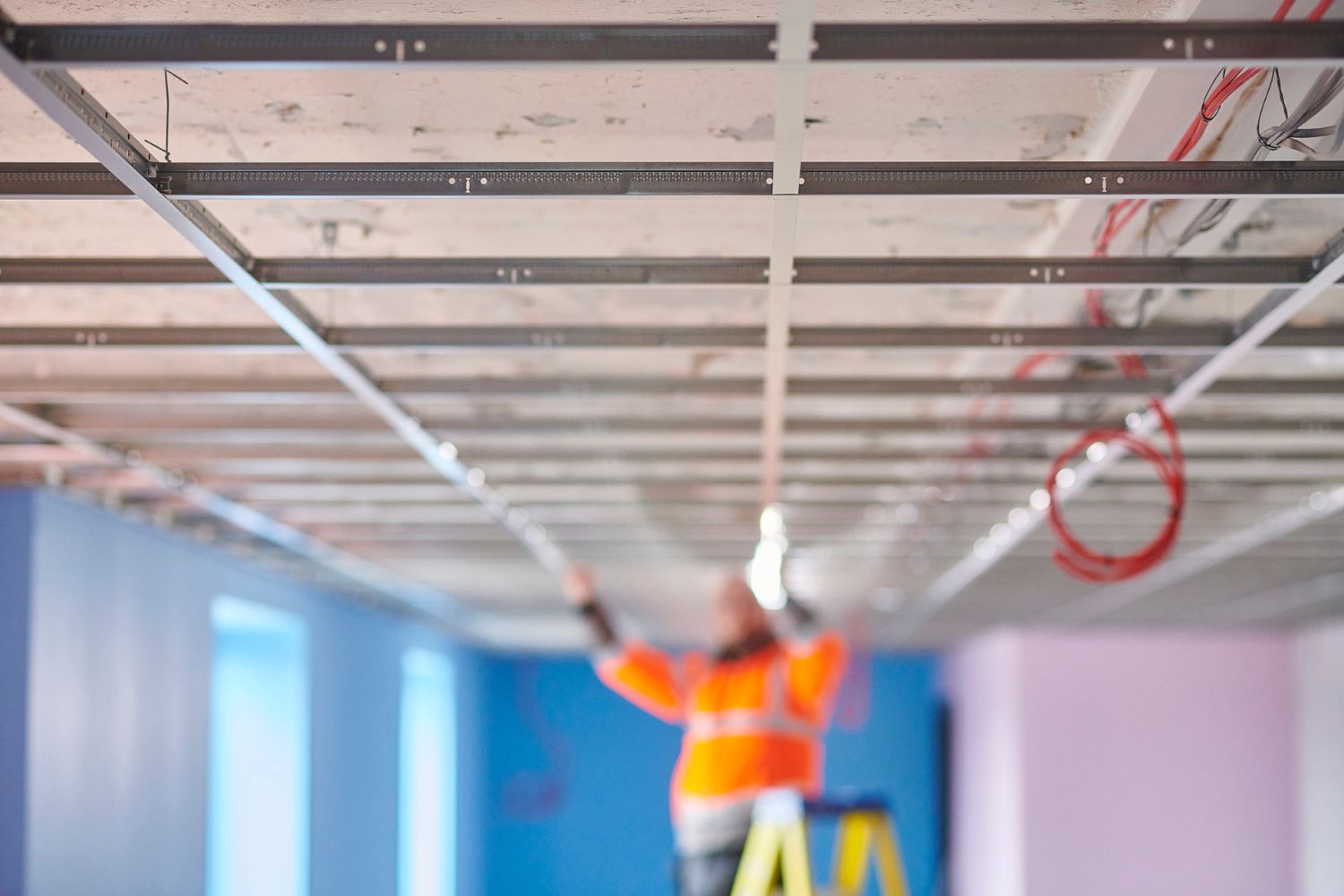
Benefits of Choosing a Drop Ceiling
A drop ceiling does more than just change a room visually; it also offers a variety of benefits from noise reduction to mold resistance and more.
“Suspended ceilings, also called drop ceilings or drop-top ceilings, offer a range of benefits compared to other types of ceilings,” says DiBara. “They make it easier to access utilities above, such as wiring, plumbing, and HVAC systems, simplifying maintenance and repairs.
Noise Reduction
Noise reduction is a top benefit of drop ceilings. Acoustic tiles specifically help absorb sound and stop it from traveling to other rooms. Additionally, the open space above a drop ceiling’s tiles acts as a sound-buffer zone, and homeowners can add additional barriers or insulation above the tiles as needed.
“Drop ceilings can enhance insulation, making them an excellent choice for basements, home theaters, or spaces where noise control is essential,” says DiBara.
Noise reduction can help improve concentration and productivity in home offices and reduce household sounds overall. An entertainment or living space with a dropped ceiling will likely offer improved acoustics for gaming or cinematic experiences. A dropped ceiling can help create quieter and more peaceful living spaces for homeowners.
Mold Resistance
Toxic mold growth that puts off dangerous mycotoxins can cause several health issues, including allergies, respiratory problems, gut inflammation, and irritation of the eyes, skin, nose, throat, and lungs. Pets may also suffer from similar health issues. An unpleasant smell can sometimes permeate a home infested with mold, though this is not always the case.
Dropped ceiling tiles are often designed to resist moisture and mold growth, with the exception of fiberglass tiles. Some manufacturers treat their tiles with antimicrobial coatings for additional protection from mold and mildew. The metal grids of drop ceilings are typically mold-resistant too. Opting for dropped ceilings can help make a home safer and healthier for both human and four-legged inhabitants while allowing that extra space needed for ductwork in the ceiling.
Recessed Lighting Compatibility
Recessed lighting is lighting that is set into a ceiling. This approach provides a sleek and modern look and offers concentrated lighting where needed. While recessed lighting is available for traditional drywalled ceilings, recessed lighting for a drop ceiling provides several advantages. With drywall, installing recessed lighting involves more planning. Any future adjustments will likely require cutting into the drywall, creating a potential mess and additional expenses for repairs.
On the other hand, dropped ceilings allow for more flexibility when it comes to lighting placement since tiles are somewhat adjustable. The grid system of a dropped ceiling also simplifies both the initial installation and any future repairs, as tiles can be easily removed and replaced as needed for access.
“Incorporate lighting into your design plans by considering fixture placement within the ceiling structure,” advises DiBara. This will allow for a seamless finish.
Quick and Easy Installation
Compared with other types of ceilings, dropped ceilings are quick and easy to install. For instance, no special tools are required, so a tape measure, bubble leveler, utility knife, and materials will go a long way for basic installation. Many of the materials are lightweight and easy to handle, and some systems are designed to snap together.
Installing the grid system takes the longest amount of time, which is why many kits are prefabricated and designed for quick and easy assembly. The grid hangs from wires attached to the overhead structure, so there’s no need to align any of the components with structural supports.
For a simple type of installation without any electrical needs, some homeowners can DIY their dropped ceilings. However, this is usually not the case, so professional labor is typically recommended to help homeowners achieve the look they want without the risks of working on ladders.
Cost-Effectiveness
Drop ceilings are often a more economical option than other ceiling materials. They’re more straightforward and often quick to install compared with drywalling and painting a ceiling. Additionally, materials for dropped ceilings aren’t overly exorbitant. And when it comes to repairs and maintenance, individual tiles are easy and affordable to replace. Dropped ceilings can reduce energy bills, offering savings beyond the initial installation.
“Materials used for drop ceilings can contribute to energy efficiency by providing insulation and reducing heat loss or gain,” explains DiBara.
Homeowners will want to keep in mind that several factors go into determining the final cost of a drop ceiling. For those weighing drop ceiling vs. drywall cost, a drop ceiling cost calculator can help. Calculating the square footage of the ceiling and multiplying by the average cost of $3.50 will provide a rough estimate.
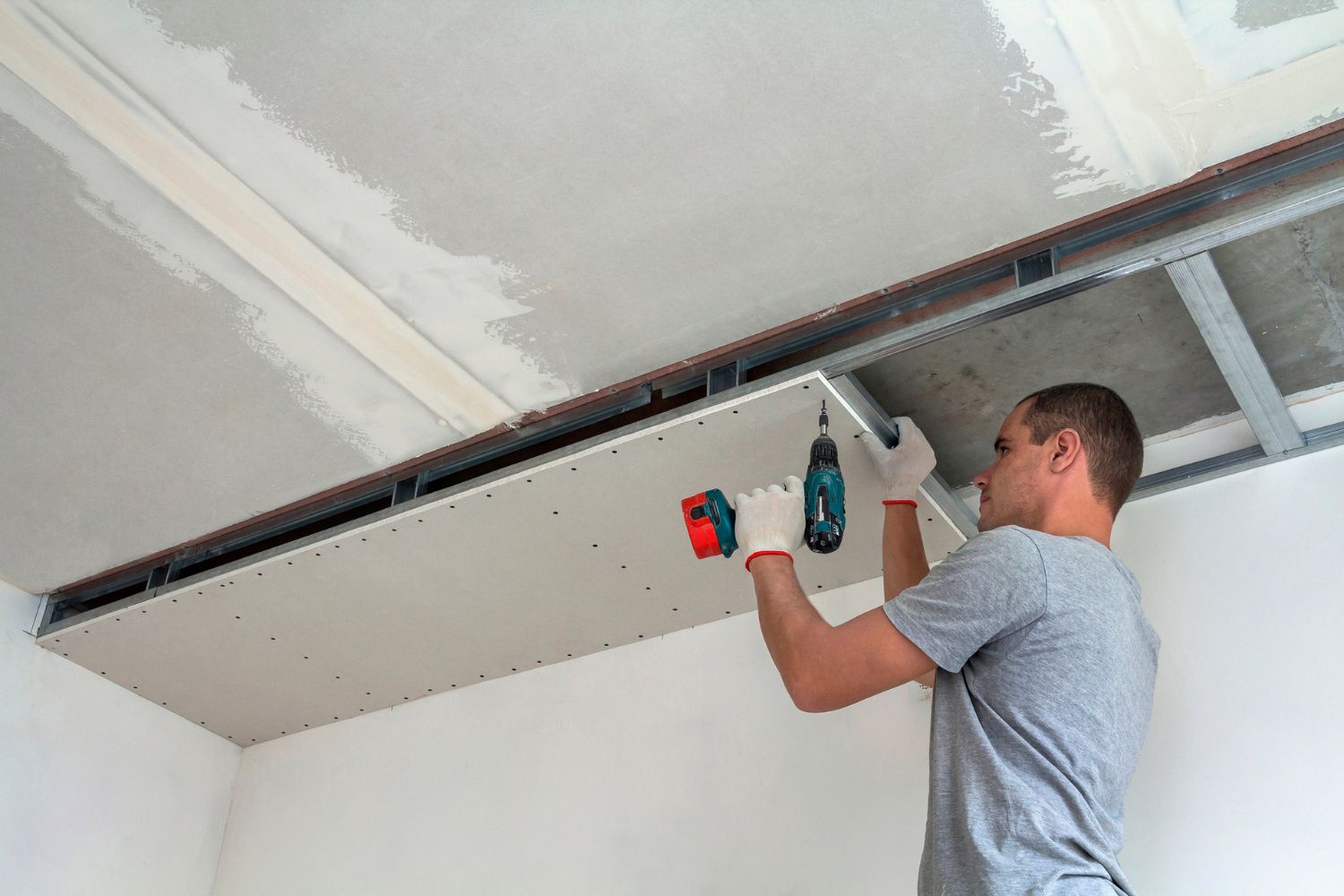
Drop Ceiling Installation: DIY vs. Hiring a Professional
A drop ceiling installation can be a significant investment for some homeowners, which may lead them to wonder if they can tackle the project on their own to save money. A DIY drop ceiling installation is possible for those who have home improvement experience, but it’s not always advisable for a few reasons.
According to DiBara, “While homeowners can install a drop ceiling themselves, it’s essential to be well-prepared and have some DIY skills. The installation typically involves measuring the area, establishing the grid system, and fitting the ceiling tiles accordingly.”
Homeowners will want to assess their skill level. Installing ceiling tiles shouldn’t be a first-time home improvement project. It’s best tackled by someone with experience in room renovations or ceiling repairs. It’s also recommended that homeowners consider whether they have the appropriate time to dedicate to a drop ceiling project. Otherwise, the project could spill into an excessive number of weekends and evenings.
Additionally, many drop ceiling projects require electrical work to reroute or install additional lighting. Electricians are qualified to safely adjust wiring and keep it up to code. A professional installation company will often subcontract with an electrician if needed, which means one less thing for the homeowner to arrange. The contractor will also manage the entire project, including the timeline, the crew, and securing materials.
Professional installers also offer safety compliance, building code knowledge, efficiency, and sometimes warranties. They may also provide unique drop ceiling ideas or suggest other types of ceilings to help homeowners find a customized solution. Overall, hiring a pro can help homeowners achieve the look they desire and with quality installation techniques that will help the ceiling last for a long time.
DiBara reiterates the advantages of hiring a pro for this project. “They bring expertise, save time, and offer warranties and quality assurance,” he says. “If you decide to tackle the drop ceiling installation yourself, it’s crucial to conduct research and planning. Follow the manufacturer’s instructions meticulously, invest in tools, and prioritize safety precautions. Undertaking this project as a DIY endeavor can be fulfilling if you feel confident in your abilities.”
How to Save Money on Drop Ceiling Cost
Drop ceilings offer a variety of benefits but come with a cost. However, homeowners have several options that can help save money on drop ceiling costs without compromising aesthetics or quality.
- Get multiple quotes. Homeowners will want to reach out to at least three providers for separate quotes to ensure they’re receiving the best value and service for the price.
- Choose standard tiles. Avoiding premium tile options can help homeowners keep material costs down.
- DIY the existing ceiling demolition. Experienced homeowners can save on labor costs by removing their existing ceilings if they are physically fit and have the tools to do so safely and without damaging ductwork or pipes in the ceiling.
- Avoid peak season. Scheduling a drop ceiling installation during slower months of the year can help avoid premium labor charges.
- Reuse materials. Whenever possible, homeowners can reuse existing materials (like an existing grid that’s in good shape) to keep costs down.
- Opt for a simple design. Sticking to a simple layout and design can help homeowners avoid a complex and lengthy installation.
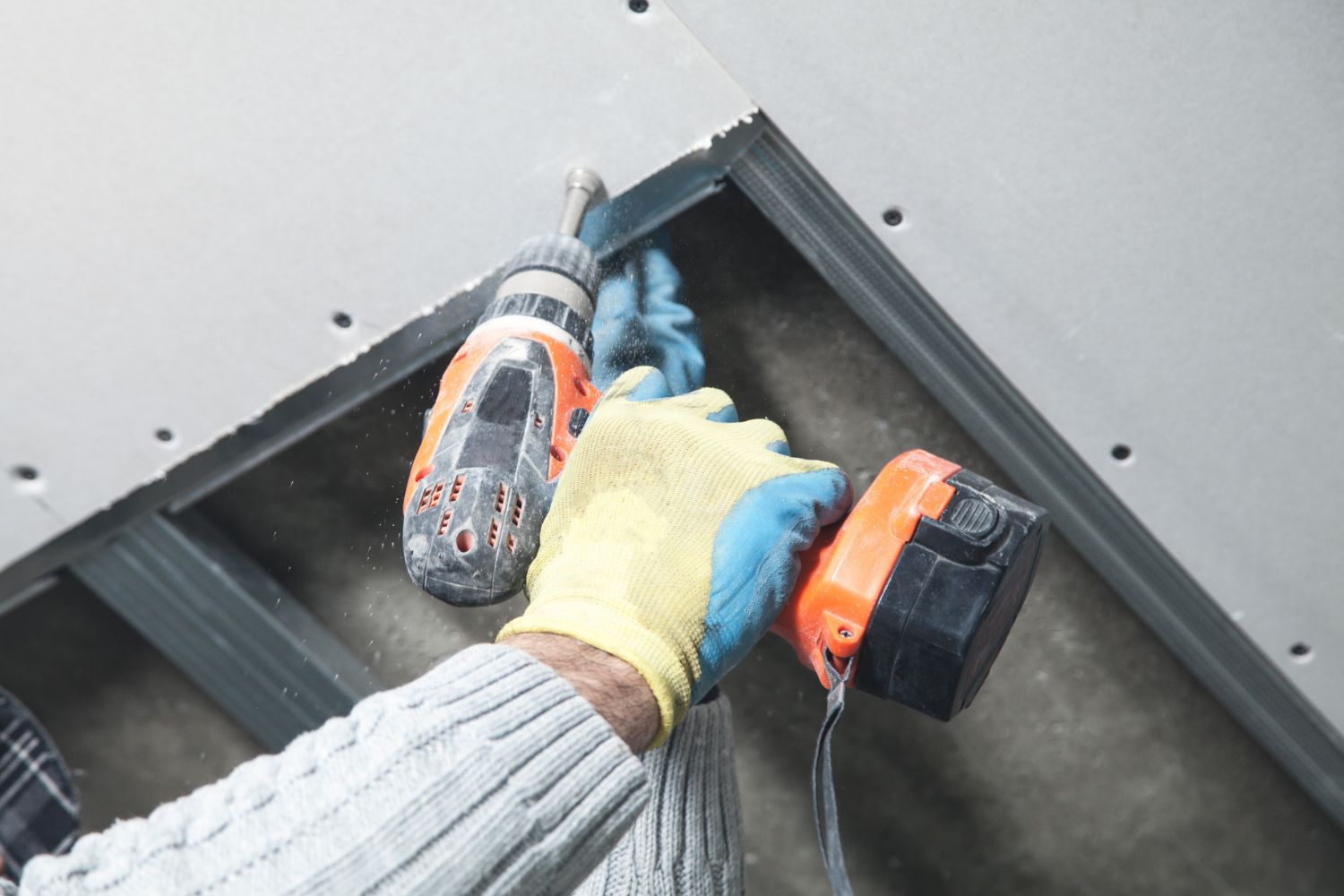
Questions to Ask About Drop Ceiling Installation
Finding the best drop ceiling installation company starts with a strong vetting process. Homeowners can ask the appropriate combination of the following questions to ensure they hire the right professional for the job.
- Are you licensed and insured for this type of work?
- How much experience do you have with drop ceiling installation?
- Do you have a portfolio or list of references you can provide?
- Do you offer a warranty or guarantee on your work?
- Is a drop ceiling the best option for my situation?
- How long can I expect installation to take?
- Will you be performing the work, or do you hire subcontractors?
- What safety precautions do you take during installation?
- What if asbestos is found?
- Do you offer a free and itemized cost estimate?
- What are your payment requirements?
- What drop ceiling material do you recommend?
- Do you handle the removal and disposal of my current ceiling system?
- Can I expect installing a drop ceiling to improve my home’s energy efficiency?
- What maintenance will my new drop ceiling require?
FAQs
A drop ceiling is a versatile and cost-effective ceiling choice for renovating several areas within a home. Drop ceilings are available in a variety of materials, each with unique benefits that cater to different needs and preferences. From easy maintenance and sound insulation to moisture and mold resistance, drop ceilings are a wise investment for many homes. For homeowners looking for a little more information on drop ceiling costs, the following questions and answers can help provide additional clarity.
Q. Is a drop ceiling good for a basement?
A drop ceiling can be a great choice for a basement. To start, a drop ceiling provides easy access to the wiring and mechanical systems hidden within the ceiling. A drop ceiling also offers faster repair options than drywall if water damage occurs. It also provides sound suppression and resists mold growth in most cases.
Q. What is the most expensive ceiling type?
A coffered ceiling may be the most expensive type of ceiling. This luxurious option features an intricate design and often includes a series of hollow panels that create a three-dimensional look. It’s a style usually found in large homes, churches, and hotels. While a coffered ceiling adds depth and texture to a room, its level of detail and installation complexity can significantly boost labor costs.
Q. What materials are needed for a drop ceiling?
A drop ceiling requires several materials, the most important being tiles. These can be made from fiberboard, plastic, metal, fiberglass, vinyl, or wood. In addition, suspended grid rails are necessary for creating the ceiling framework, while insulation tile backing is an optional material that adds another thermal barrier. Finally, decorative rail covers and installation accessories, including wires and clips, may also be required.
Sources: Angi, HomeAdvisor, Fixr, HomeGuide
